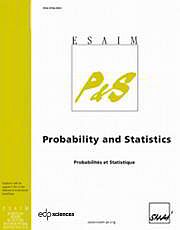Crossref Citations
This article has been cited by the following publications. This list is generated based on data provided by Crossref.
Kenyon, Richard
2000.
The asymptotic determinant of the discrete Laplacian.
Acta Mathematica,
Vol. 185,
Issue. 2,
p.
239.
Benjamini, Itai
Lyons, Russell
Peres, Yuval
and
Schramm, Oded
2001.
Uniform spanning forests.
The Annals of Probability,
Vol. 29,
Issue. 1,
Agrawal, Himanshu
and
Dhar, Deepak
2002.
Probability distribution of the sizes of the largest erased loops in loop-erased random walks.
Physical Review E,
Vol. 65,
Issue. 3,
Benjamini, Itai
and
Wilson, David
2003.
Excited Random Walk.
Electronic Communications in Probability,
Vol. 8,
Issue. none,
Shiraishi, Daisuke
2010.
Heat kernel for random walk trace on ℤ3 and ℤ4.
Annales de l'Institut Henri Poincaré, Probabilités et Statistiques,
Vol. 46,
Issue. 4,

